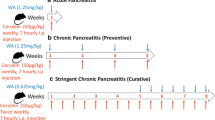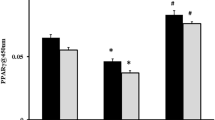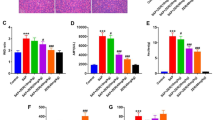Abstract
Objective
Nuclear factor-κB (NF-κB) is a transcription factor which plays a pivotal role in the induction of genes involved in the response to injury and inflammation. Calpain I inhibitor is a potent antioxidant which is an effective inhibitor of NF-κB. This study examined whether the postulate that calpain I inhibitor attenuates experimental acute pancreatitis.
Design and setting
In a murine model we measured NF-κB activation, expression of intercellular adhesion molecule (ICAM) 1, nitrotyrosine, inducible nitric oxide synthase (iNOS), nuclear enzyme poly(ADP-ribose) synthetase (PARS), myeloperoxidase, malondialdehyde, amylase and lipase and determined histological evidence of lung and pancreas injury in four groups: control (saline only), cerulein, calpain I inhibitor plus cerulein and calpain I inhibitor plus saline.
Measurements and results
Intraperitoneal injection of cerulein in mice resulted in severe, acute pancreatitis characterised by oedema, neutrophil infiltration, tissue haemorrhage and necrosis and elevated serum levels of amylase and lipase. Infiltration of pancreatic and lung tissue with neutrophils (measured as increase in myeloperoxidase activity) was associated with enhanced lipid peroxidation (increased tissue levels of malondialdehyde). Immunohistochemical examination demonstrated a marked increase in immunoreactivity for nitrotyrosine, iNOS and PARS in the pancreas and lung of cerulein-treated mice. In contrast, pre-treatment with calpain I inhibitor markedly reduced: the degree of pancreas and lung injury; upregulation/expression of ICAM-1; staining for iNOS, nitrotyrosine and PARS; and lipid peroxidation. Additionally, calpain I inhibitor treatment significantly prevented the activation of NF-κB as suggested by the inhibition of IκB-α; degradation in the pancreas tissues after cerulein administration.
Conclusions
Taken together, our results clearly demonstrate that prevention of the activation of NF-κB by calpain I inhibitor ameliorates experimental murine acute pancreatitis.



Similar content being viewed by others
References
McKay CJ, Evans S, Sinclair M, Carter CR, Imrie CW (1999) High early mortality rate from acute pancreatitis in Scotland, 1984–1995. Br J Surg 86:1302–1305
Powell JJ, Fearon KCH, Siriwardena AK (2000) Current concepts of the pathophysiology and treatment of severe acute pancreatitis. Br J Intensive Care 10:51–59
Rau B, Poch B, Gansauge F, Bauer A, Nussler AK, Nevalainen T, Schoenberg MH, Beger HG (2000) Pathophysiologic role of oxygen free radicals in acute pancreatitis. Ann Surg 231:352–360
Arrigo AP, Kretz-Remy C (1998) Regulation of mammalian gene expression by free radicals. In: Aruoma OI, Halliwell B (eds) Molecular biology of free radicals in human diseases. Oica International, London, pp 183–189
Gukovsky I, Gukovskaya AS, Blinman TA, Zaninovic V, Pandol SJ (1998) Early NF-κB activation is associated with hormone-induced pancreatitis. Am J Physiol 275:G1402–G1414
Schwartz MD, Moore EE, Moore FA, Shenkar R, Moine P, Haenel JB, Abraham E (1996) Nuclear factor-kappa B is activated in alveolar macrophages from patients with acute respiratory distress syndrome. Crit Care Med 24:1285–1292
Baeuerle PA, Baltimore D (1996) NF-κB: ten years after. Cell 87:13–20
Bowie A, O’Neil LA (2000) Oxidative stress and nuclear factor-kappaB activation: a reassessment of the evidence in the light of recent discoveries. Biochem Pharmacol 59:13–23
Cuzzocrea S, McDonald MC, Mazzon E, Mota-Filipe H, Centorrino T, Terranova ML, Ciccolo A, Britti D, Caputi AP, Thiemermann C (2001) Calpain inhibitor I reduces colon injury caused by dinitrobenzene sulphonic acid in the rat. Gut 48:478–488
Saido TC, Sorimachi H, Suzuki K (1994) Calpain: new perspectives in the molecular diversity and physiological-pathological involvement. FASEB J 8:814–822
Chatterjee PK, Brown PA, Cuzzocrea S, Zacharowski K, Stewart KN, Mota-Filipe H, McDonald MC, Thiemermann C (2001) Calpain inhibitor-1 reduces renal ischemia/reperfusion injury in the rat. Kidney Int 59:2073–2083
Mullane KM, Kraemer R, Smith B (1985) Myeloperoxidase activity as a quantitative assessment of neutrophil infiltration into ischemic myocardium. J Pharmacol Methods 14:157–167
Ohkawa H, Ohishi N, Yagi K (1979) Assay for peroxidases in animal tissues by thiobarbituric acid reaction. Anal Biochem 95:351–358
Cuzzocrea S, Zingarelli B, Hake P, Hake P, Salzman AL, Szabo C (1998) Anti-inflammatory effects of mercaptoethylguanidine, a combined inhibitor of nitric oxide synthase and peroxynitrite scavenger, in carrageenan-induced models of inflammation. Free Radic Biol Med 24:450–459
Cuzzocrea S, Rossi A, Pisano B, Di Paola R, Genovese T, Patel NS, Cuzzocrea E, Ianaro A, Sautebin L, Fulia F, Chatterjee PK, Caputi AP, Thiemermann C (2003) Pyrrolidine dithiocarbamate attenuates the development of organ failure induced by zymosan in mice. Intensive Care Med 29:2016–2025
Sorimachi H, Ishiura S, Suzuki K (1997) Structure and physiological function of calpains. Biochem J 328:721–732
Saido TC, Sorimachi H, Suzuki K (1994) Calpain: new perspectives in molecular diversity and physiological-pathophysiological involvement. FASEB J 8:814–822
Wang KK, Yuen PW (1994) Calpain inhibition: an overview of its therapeutic potential. Trends Pharmacol Sci 15:412–419
Siebenlist U, Franzoso G, Brown K (1994) Structure, regulation and function of NF-kappa B. Annu Rev Cell Biol 10:405–455
Griscavage JM, Wilk S, Ignarro LJ (1996) Inhibitors of proteosome pathway interfere with induction of nitric oxide synthase in macrophages by blocking activation of transcription factor NF-kappa B. Proc Natl Acad Sci USA 93:3308–3312
Crofford LJ, Tan B, McCarthy CJ, Hla T (1997) Involvement of nuclear factor kappa B in the regulation of cyclooxygenase-2 expression by interleukin-1 in rheumatoid synoviocytes. Arthritis Rheum 40:226–236
Powell JJ, Fearon KCH, Siriwardena AK (2000) Current concepts of the pathophysiology and treatment of severe acute pancreatitis. Br J Intensive Care 10:51–59
Acknowledgements
This study was supported by the award of the Travelling Fellowship of the Pancreatic Society of Great Britain and Ireland. The authors would like to thank Giovanni Pergolizzi and Carmelo La Spada for their excellent technical assistance during this study, Mrs. Caterina Cutrona for secretarial assistance and Miss Valentina Malvagni for editorial assistance with the manuscript. CT is a Senior Fellow of the British Heart Foundation (FS 96/018).
Author information
Authors and Affiliations
Corresponding author
Rights and permissions
About this article
Cite this article
Virlos, I., Mazzon, E., Serraino, I. et al. Calpain I inhibitor ameliorates the indices of disease severity in a murine model of cerulein-induced acute pancreatitis. Intensive Care Med 30, 1645–1651 (2004). https://doi.org/10.1007/s00134-004-2328-z
Received:
Accepted:
Published:
Issue Date:
DOI: https://doi.org/10.1007/s00134-004-2328-z




